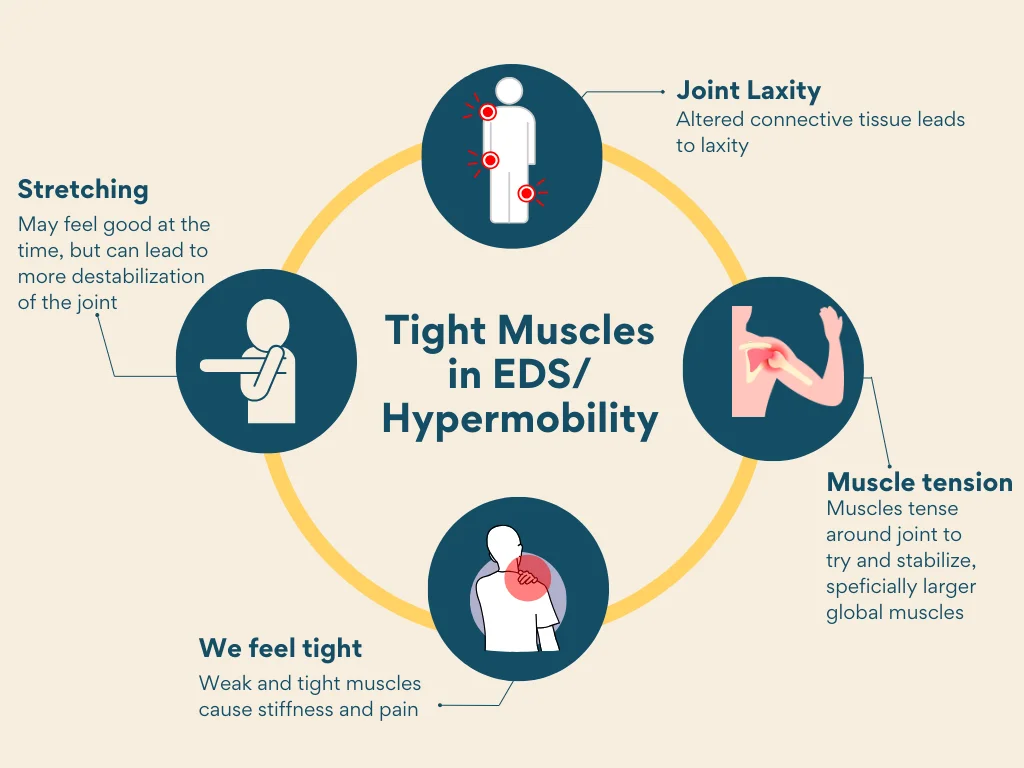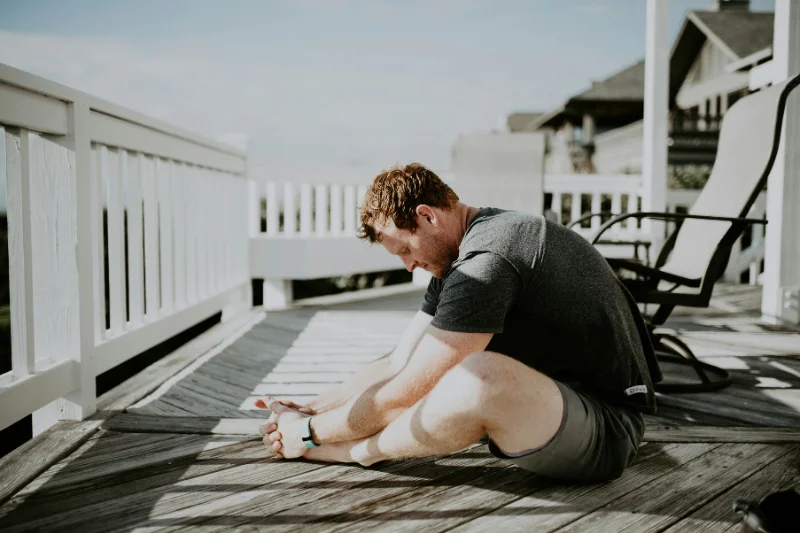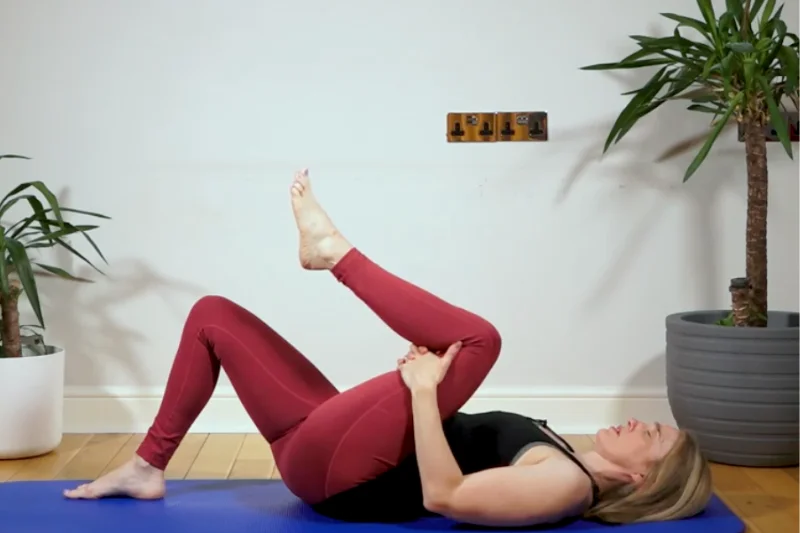
Estimated reading time: 8 minutesDo you wake up feeling stiff and achy? Lack of movement overnight can make us feel very stiff in the morning. Maybe your tension increases as the day progresses.
If you live with hypermobility or EDS, you probably know how frustrating it is to feel tight and stiff despite having joint laxity.
You may find your tissues stiffen up to protect you overnight, as the natural relaxation during sleep can cause subluxations. Even asleep, our brains will be ready to protect us.
Many health professionals are surprised by this and mistake the stiffness for a lack of hypermobility.
This can lead to diagnosis delays, misdiagnosis, and dismissal, sadly. But having a connective tissue disorder is much more complex than simply being bendy and loose.
So why are our muscles tense and sore when our joints are so mobile? Let’s explore this phenomenon in the blog in more detail.
What Causes Muscle Tension in Hypermobility and EDS?
I have heard this question many times: if my joints are so loose, why do I feel so tight? To this, I say there are many causes of tension in hypermobility and EDS, and one of these is the body’s search for stability.
When our joints and ligaments are too lax, the body still needs to find stability. Otherwise, we would just collapse in a heap on the floor.
The body searches for stability, and one way it does this is by asking the muscles to do more work. This is what I call false stability. The joints may also lock or hyperextend as a form of finding stability, and this will also put the muscles under extra stretch and tension.
Both of these options are subconscious to some degree; many people are not aware they are locking their joints to stand up, for example (me included for most of my life).
The muscles tighten as a protective response; the body senses the joint laxity and takes action by tightening up the surrounding tissue. The muscles begin guarding or bracing. These tight muscles can also pull on lax joints, leading to imbalances (1).
The problem with this is that the muscles are no longer doing the job they were designed to do. It is often the big global muscles that are recruited for the extra work.
They take over the job that deep stabilizing muscles should be doing. The big global muscles get tired and angry at this extra work and become sore and tight.
We can end up with a cycle:
- Muscles tighten to protect lax joints
- This results in feeling stiff and restricted
- We desire to stretch, which gives temporary relief
- The cycle repeats itself because the stretch has destabilized the joint further
It is a vicious cycle, but one that we can change with the right movement therapy.

Why Do Muscles Feel Tight and Weak at the Same Time?
This is another confusing element related to hypermobility; we feel tight and weak. I believe this is because you can’t strengthen a tired muscle.
It is important to remember that a fatigued, angry muscle will let you down eventually.
Often, the big global power muscles have been asked to do the stabilizing job they weren’t designed for, trying to stabilize the body. So, they feel tired, weak, and stiff.
They are working in a way that is not suitable for them to generate power. They are overworking to try and provide stability, but don’t have the true strength and endurance they need.
One example of this is the rectus abdominus, or the abs, a powerful muscle. We overuse this and often end up with very tight abs.
When I first started doing pilates, my abs would burn a lot because I wasn’t recruiting the deeper stabilising muscles of the trunk, like the pelvic floor muscles, transverse abs.
Another classic is tight hamstrings and dominant quads. These are often actually weak because they are not used correctly. The deep hip stabilisers are often neglected as the quads take over & hamstrings grip to hold everything together.
That is where the deep stabilizer muscles should step up. However, with hypermobile bodies, we often need to teach the stabilizers how to engage.
If you’ve ever had a muscle tremble when it is asked to work in a controlled way, that’s part of the learning process. The stabilizers are learning how to do their job.
Ultimately, muscle strength can improve joint stability and help with widespread pain (1).

Photo by Scott Broome on Unsplash
Should You Stretch Tight Muscles If You’re Hypermobile?
For many people with hypermobility, repeated stretching of already unstable joints can actually increase symptoms of pain and instability in the long run. But it feels so good to stretch!
I used to stretch all the time, but it only ever gave me temporary relief. Now that I have more balanced movement and control in my body and overall postural tone, I don’t feel the need to stretch anymore like I used to.
Remember, a muscle is tight for a reason. It is trying to protect and guard your joints. Stretching will override that protective mechanism temporarily.
If the fascia feels threatened by stretch, it can actually become tighter as a result, and we never actually change anything. We need to treat our connective tissue gently and respectfully to avoid injury.
I am not against stretching, but it needs to be done in a way that is appropriate for hypermobile bodies. That leans more towards dynamic over static stretching.
Should I stretch or strengthen?
I’ve found the secret to whether you should stretch or strengthen is all about balance in the whole structure. The most effective long-term strategy is to teach your system balanced support, as opposed to gripping and bracing muscles.
This means gentle, controlled, safe movements over endless stretching. That’s how the Integral Movement Method, my approach to movement therapy, came about.
Strengthening doesn’t mean we need to start weightlifting immediately. In fact, we need to start with low-load, slow, controlled, and mindful movements that help your body feel safe and supported.
We need to learn control and work on our proprioception (our sense of where the body is in space that is altered in EDS), as many of us can easily go beyond a normal range of motion and hyperextend with exercise.
Going slow is also thought to avoid irritating unstable joints and surrounding “easy-to-irritate muscles and ligaments.” There is even some evidence that these respond differently to muscle activation in hypermobility (1).
I believe strength work is often prescribed way too soon to hypermobile people when they are just not ready to do it in a safe, injury-free way. This often leads to more pain, tension, and flare-ups.
The IMM prioritizes strengthening in the right order. Over time, with the correct method, the protective tightness eases because the body no longer feels the need to hold on and grip.
We need to go through a process of unwinding first, to start to ease that tension so we can start to strengthen. Unwind is the first step in the IMM.

Jeannie does a gentle dynamic stretch in the Relieve Coccyx Pain video in The Zebra Club app.
Safe Ways to Relieve Muscle Tension With EDS/Hypermobility
There are safe, gentle ways to relieve muscle tension without causing more instability or overstretching.
I know it’s a strange concept and feels counterintuitive to NOT approach tightness by stretching, but my unique approach in the IMM really brings balance to the body and ensures the right muscles are doing their right job.
- Gentle movement – low load and mindful exercises that ideally start with breath and relaxation techniques to create a sense of safety. No muscle is going to relent if it does not feel safe. Some of this included gentle dynamic stretching!
- Breathwork – many of us hold unconscious tension in the tissues. It can lead to dysfunctional breathing patterns that can also lead to muscular tension, especially in the thorax and pelvis.
- Relaxation – it is super important to spend time with exercises like body scans or supine work, where the body can release tension
- Isometric exercises – these are essential and the first step to strengthening. Holding a muscle contraction without moving the joint can calm the tension and build strength
- Pacing – less is more. We need to try and avoid the boom and bust cycle that is common. We can do too much to try and relieve this tightness, and overactivity can make the muscles clamp down and become stiffer. Too much rest can also cause stiffness, so it comes back to balance.
- Heat – heating pads and baths can feel great for tension relief. Be careful with baths if you have Dysautonomia or POTS.
Why Massage Gives Temporary Relief But Doesn’t Last
We often go right to massage for muscle tension, but we need to be careful when it comes to massage and hypermobility. I have heard many times from clients and members of The Zebra Club about having a massage that felt great at the time, but later that day or the next morning, they woke up with even more tension than they started with.
I do love a good massage with an anatomy and fascia-informed therapist. It is wonderful to feel the tension being eased away. We need to go carefully and not go too deep, as this can destabilize many hypermobile bodies.
The relief is often temporary because a massage addresses the symptom – eg, tight muscles- but not the underlying cause of the tightness – eg, instability and lack of support.
As I said before, the tension is often there as the body’s way of stabilizing an unstable joint. If we just go in and remove that tension, what happens to the joint?
Once we return to our daily activities, movement patterns, and postures, the body will spring back to what it knows. It knows gripping and guarding to support the body.
This doesn’t mean massage isn’t good or a waste of time. It can be super helpful for relaxation and me time. And not all approaches to massage are equal; there are different approaches that may be more beneficial for relieving pain.
I also think it works best when combined with an active strategy like movement therapy or exercise that also works on balance, support, strength, and nervous system regulation.
When to Seek Professional Help
If you have concerns about muscle tightness and pain, it is always advisable to see a physical therapist or physiotherapist, or a movement professional, and get some advice. It can be hard to tell what is normal with EDS. A professional opinion can be helpful.
I would seek guidance from a professional if:
- Muscle tightness interferes with your daily life
- You experience repeated muscle spasms and cramps
- Pain gets much worse with gentle movement
Key Takeaways: Living With Tight Muscles and Hypermobility
- First of all, it is quite normal to feel like this. Muscle tightness with hypermobility is quite complex and often misunderstood in the medical world. You are not doing anything wrong – this is your body’s way of protecting and helping you. It thinks your connective tissue isn’t providing enough stability, and with EDS, it’s probably right.
- There is much we can do to resolve these issues. Relief can come from supporting the body with safe, appropriate movement, nervous system regulation, and pacing.
- This change won’t happen overnight, the body is used to working in a certain way. We need to reprogram how your body responds to movement and load. But over time, your muscles will learn to feel safer, stronger and able to do the job they were designed to do.
If you’d like guided support in this journey, The Zebra Club offers a library of safe classes and resources specifically for hypermobility.
Here is a video I made talking about why we may feel stiff but loose.
FAQ
If my joints are so loose, why do my muscles feel so tight?
In Ehlers-Danlos syndrome (EDS) and hypermobility spectrum disorder (HSD), muscles often tighten to protect unstable joints. This protective muscle guarding overworks the muscles, making them feel tense or stiff even though the joints are flexible.
Should I stretch my tight muscles if I have EDS?
Stretching with EDS requires caution. Static stretching may overstretch already loose tissues and destabilize joints. A safer approach is dynamic movement, gentle strengthening, and fascia-friendly release techniques that support stability without pushing joints beyond their safe range.
Why do I wake up so stiff despite having hypermobile joints?
Overnight, muscles and fascia tighten as a protective response to joint laxity. Inactivity during sleep can add to stiffness. A gentle morning routinecan ease tightness and prepare the body for the day.
Is yoga bad for people with EDS?
Yoga is not automatically harmful, but traditional poses may encourage overstretching or “hanging” in joints. Modified yoga that focuses on alignment, strength, and control can be beneficial if guided by an instructor familiar with hypermobility.
Can strengthening exercises really help EDS muscle tightness?
Yes. Gentle, progressive strengthening helps stabilize joints, reduce overcompensation, and improve muscle endurance. Over time, building strength can ease the sensation of chronic tightness and provide more reliable support for hypermobile joints.
Can muscles be both weak and tight at the same time in hypermobility?
Absolutely. In hypermobility, tightness does not equal strength. Muscles often contract excessively to stabilize loose joints, leaving them feeling tense but still lacking true power or resilience.
Is muscle tension linked to fatigue and pain in hypermobility?
Yes. Constant muscle guarding and gripping use significant energy, which can lead to fatigue, widespread pain, and soreness. Nervous system regulation, pacing, and gentle strengthening are important strategies to reduce this cycle.


2 Comments
Sophia M - 20th November 2025
I’ve seen your videos on YouTube and I got to say you are such an inspiration and have helped me and my family so much. I have been searching for help for so long and it’s been so hard with waiting lists and what not. It’s nice to know I can find helpful information without a doctor.
Jeannie Di Bon - 26th November 2025
Thank you so much for taking the time to write and let me know. This means a lot. I am so happy to help.